IMPLICATIONS OF CARBON-BORDER ADJUSTMENT MECHANISM (CBAM) AND ITS RAMIFICATIONS IN ACHIEVING SUSTAINABLE DEVELOPMENT GOALS AND THE UNITED NATIONS 2030 AGENDA
IMPLICATIONS OF CARBON-BORDER ADJUSTMENT MECHANISM (CBAM) AND ITS RAMIFICATIONS IN ACHIEVING SUSTAINABLE DEVELOPMENT GOALS AND THE UNITED NATIONS 2030 AGENDA
Author(s): Unmana SarangiSubject(s): Energy and Environmental Studies, International Law, Economic development
Published by: Międzynarodowy Instytut Innowacji "Nauka - Edukacja - Rozwój"
Keywords: CBAM; EU-CBAM Certificates; Decarbonization; Climate Action; International Cooperation; UNFCCC;
Summary/Abstract: The research paper entitled “Implications of Carbon-Border Adjustment Mechanism (CBAM) and Its Ramifications in Achieving Sustainable Development Goals and the United Nations 2030 Agenda” is an attempt to study the definition, objective, purpose and coverage of implementation of CBAM and its implications in achieving United Nations Sustainable Development Goals and the 2030 Agenda. The concept of Carbon Border Adjustment Mechanism (CBAM) was conceived and developed by the European Union (EU) across its regions and territories. The CBAM regulation entered into force on 16 May 2023 and was adopted by the EU. According to the EU, the CBAM itself will enter into application in its transitional phase on 1 October 2023, with the first reporting period for importers ending 31 January 2024. It will initially apply to imports of certain goods and selected precursors/sectors/segments/industries whose production is carbon intensive and at most significant risk of carbon leakage: cement, iron and steel, aluminium, fertilisers, electricity and hydrogen. With this enlarged scope, CBAM will eventually when fully phased in, capture more than 50 percent of the emissions in ETS covered sectors. The objective of this transition period is to serve as a pilot and learning period for all stakeholders i.e. importers, producers and authorities and to collect useful information on embedded emissions to refine the methodology for the definitive period in question.
Journal: International Journal of Legal Studies (IJOLS)
- Issue Year: 14/2023
- Issue No: 2
- Page Range: 603-620
- Page Count: 18
- Language: English

